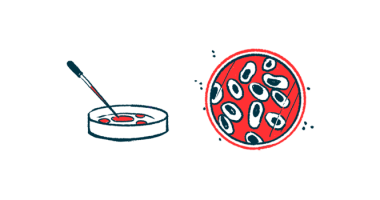Potential Therapy for Dopaminergic Neurons, CNM-Au8, Enter Phase 2 Trial in Parkinson’s Patients

CNM-Au8, an investigational therapy by Clene Nanomedicine, improved the survival of dopaminergic neurons, helped prevent loss of mitochondria, and rescued motor function in a rat model of Parkinson’s disease, a study reports.
The effects of CNM-Au8 will now be assessed in an open-label (no placebo group) Phase 2 trial, called REPAIR-PD (NCT03815916). This pilot study is enrolling up to 24 patients who will undergo treatment at the University of Texas Southwestern Medical Center. More information can be found here.
Karen Ho, Clene’s head of translational medicine, presented the preclinical findings in the scientific poster, “Gold nanocatalysis as a novel therapeutic for neuroprotection in Parkinson’s disease,” during the recent 2019 Society for Neuroscience (SfN) Annual Meeting in Chicago.
Parkinson’s disease is characterized by the degeneration and death of a particular group of nerve cells — called dopaminergic neurons — in two brain regions, the striatum and the substantia nigra.
To work as intended, these nerve cells require large amounts of energy, which is provided by mitochondria: small organelles within cells that work as their powerhouses. Failure to provide the energy cells need contributes to their death.
Another key player in Parkinson’s is oxidative stress, an imbalance between the production of harmful free radicals and the ability of cells to detoxify them. These free radicals, or reactive oxygen species, are produced during certain metabolic reactions in which mitochondria are involved, and damage cells.
CNM-Au8 is a suspension of nanocrystalline gold that acts to increase the speed of certain intracellular reactions. Specifically, CNM-Au8 is designed to increase the conversion of nicotinamide adenine dinucleotide (NADH) to its oxidized form (NAD+), resulting in greater production of ATP, a key energy-carrying molecule used by mitochondria. In addition, CNM-Au8 has antioxidant properties that may help to protect cells against oxidative stress.
In the preclinical study, researchers treated co-cultures of rat dopaminergic neurons and glial cells (cells that surround neurons and provide them with support) with CNM-Au8. This significantly increased the total intracellular levels of NAD+ compared to treatment with the control, a reaction that leads to greater release of ATP.
Exposing these co-cultures to two neurotoxins — substances that damage the nervous system and mimic what occurs in Parkinson’s — called MPP+ (1-methyl-4-phenylpyridinium) and 6-OHDA, led to damage and death of dopaminergic neurons. However, treatment with CMN-Au8 significantly increased these neurons’ survival and helped to preserve the network generated by nerve cells.
In cells exposed to 6-OHDA, use of CNM-Au8 led to fewer clumps of alpha-synuclein protein, an established hallmark of Parkinson’s disease.
CNM-Ai8 treatment also halted the accumulation of reactive oxygen species, and significantly lessened the loss of mitochondria induced by exposure to the neurotoxin MPP+.
“We are excited to share these latest Parkinson’s disease neuroprotection data regarding our lead nanocatalyst, CNM-Au8, with the neuroscience research community,” Rob Etherington, the president and CEO of Clene, said in a press release.
“Coupled with prior neuroprotection and remyelination data presented at major scientific congresses, this new Parkinson’s data demonstrate how improvements in bioenergetics with CNM-Au8 may preserve neuronal viability across multiple neurodegenerative disorders,” Etherington added.
CNM-Au8 was also tested in vivo (living organism) in a rat model of Parkinson’s disease. 6-OHDA was injected into the right side of the animals’ striatum. These rats were then given CNM-Au8 or a sham solution daily, delivered orally, beginning the next day (early treatment) or 14 days later (late treatment group).
Locomotor function in the rats was assessed using the vertical cylinder paw placement test after six weeks. Results showed that animals treated with CNM-Au8, either early or later, had improvements in motor activity compared to control (untreated) mice.
Early treatment with CNM-Au8 also reduced the number of apomorphine-induced rotations (circling, which signals problems) in rats with lesions at week six by 42% compared to control rats.
Notably, rats treated with CNM-Au8 in this test also showed better results compared to rats treated with carbidopa/levodopa, a standard Parkinson’s therapy.
“These data support our belief that treatment with CNM-Au8 may improve the survival of dopaminergic neurons in patients with PD, thereby helping slow the progression of this devastating disease. Disease modifying therapies remain a key, unmet treatment goal in Parkinson’s disease,” Etherington said.
CNM-Au8 was shown to be safe in a Phase 1 clinical trial involving healthy volunteers (NCT02755870).
In the REPAIR-PD study, participants will first undergo a four-week screening period, after which they will drink two ounces of CNM-Au8 daily each morning for 12 weeks. Treatment will be followed by a four-week follow-up period.
The study’s primary outcome is to determine improvements in oxidative stress in the central nervous system (brain and spinal cord), assessed by the ratio of NAD+/NADH measured using magnetic resonance spectroscopy (MRS).
Additional (secondary) measures include assessing the effects of CNM-Au8 on energy production and nerve cells’ metabolism. Results are expected by mid-2020.
“We are excited to be advancing CNM-Au8 into studies in Parkinson’s patients starting with the REPAIR-PD Phase 2 study,” said Robert Glanzman, Clene’s chief medical officer. “This study will advance our understanding how CNM-Au8 treatment affects central nervous system biomarkers related to bioenergetics, neuronal metabolism, and oxidative stress, as potential indicators of target engagement for CNM-Au8.”






